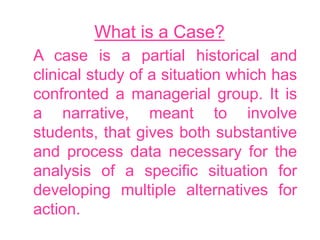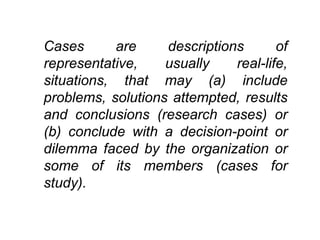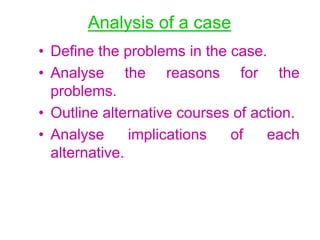CASE STUDY.ppt
- 1. What is a Case? A case is a partial historical and clinical study of a situation which has confronted a managerial group. It is a narrative, meant to involve students, that gives both substantive and process data necessary for the analysis of a specific situation for developing multiple alternatives for action.
- 2. Cases are descriptions of representative, usually real-life, situations, that may (a) include problems, solutions attempted, results and conclusions (research cases) or (b) conclude with a decision-point or dilemma faced by the organization or some of its members (cases for study).
- 3. âĒ A case study presents an account of what happened to an individual, a business or industry over a number of years. âĒ It chronicles events that a manager has to deal with. âĒ Each case is different because each organization is different.
- 4. Analysis of a case âĒ Define the problems in the case. âĒ Analyse the reasons for the problems. âĒ Outline alternative courses of action. âĒ Analyse implications of each alternative.
- 5. Why Cases? 1) The participant will be like a detective who, with a set of conceptual tools, probes what happened and what or who was responsible, and then marshals the evidence that provides the solution. 2) They provide the participants opportunities to participate in discussions and gain experience in presenting their ideas to others.
- 6. 3) Dialectical Approach to Decision making You have to organize your views and conclusions so that you can present them to the group. The other participants might have analyzed the issues differently. You will have to argue your points before they accept your conclusions.
- 7. 4) If you work in groups, you will learn about group processes involved in your joint work. -it is often difficult to schedule your time -allocate responsibility -manage members who shirk their responsibilities -try to dominate groupâs analysis -strategic management takes place in groups
- 8. Management, like anatomy, involves knowledge which must be learned. A closer analogy would be to clinical medicine, which is a skill that must also be practiced. The enhancement of skill involves active participation. This is what a case method relies on.
- 9. The whiteness of the rice comes not from the rod but from the friction among the grains
- 10. Objectives that are realistic âĒ To increase participantsâ sensitivity to human and organizational aspects of administration and their skills in dealing with them âĒ To increase participantsâ skill in understanding and dealing with interpersonal behavior: superiors, colleagues, subordinates, customers and others.
- 11. âĒ To increase the ability to think about organizational components of a situation they are dealing with. This involves such matters as the range of data to take into account in dealing with management issues; questions of authority and responsibility & channels of communication. âĒ To help them become more proactive in handling management problems.










